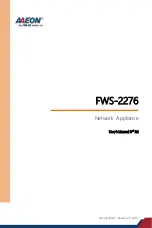
30-11
Cisco Catalyst Blade Switch 3130 and 3032 for Dell Software Configuration Guide
OL-12247-04
Chapter 30 Configuring SPAN and RSPAN
Configuring SPAN and RSPAN
ACL permits it. But if the security output ACL denies a packet and it is not sent, it is not copied to the
SPAN destination ports. However, if the security output ACL permits the packet to go out, it is only
copied to the SPAN destination ports if the FSPAN ACL permits it. This is also true for an RSPAN
session.
You can attach three types of FSPAN ACLs to the SPAN session:
•
IPv4 FSPAN ACL— filters only IPv4 packets.
•
IPv6 FSPAN ACL— filters only IPv6 packets.
•
MAC FSPAN ACL— filters only non-IP packets.
The security ACLs have higher priority than the FSPAN ACLs on a switch. If FSPAN ACLs are applied,
and you later add more security ACLs that cannot fit in the hardware memory, the FSPAN ACLs that
you applied are removed from memory to allow space for the security ACLs. A system message notifies
you of this action, which is called
unloading
. When there is again space for the FSPAN ACLs to reside
in memory, they are added to the hardware memory on the switch. A system message notifies you of this
action, which is called
reloading
. The IPv4, IPv6 and MAC FSPAN ACLs can be unloaded or reloaded
independently.
If a VLAN-based FSPAN session configured on a stack cannot fit in the hardware memory on one or
more switches, it is treated as unloaded on those switches, and traffic meant for the FSPAN ACL and
sourcing on that switch is not copied to the SPAN destination ports. The FSPAN ACL continues to be
correctly applied, and traffic is copied to the SPAN destination ports on the switches where the FSPAN
ACL fits in the hardware memory.
When an empty FSPAN ACL is attached, some hardware functions copy all traffic to the SPAN
destination ports for that ACL. If sufficient hardware resources are not available, even an empty FSPAN
ACL can be unloaded.
IPv4 and MAC FSPAN ACLs are supported on all feature sets. IPv6 FSPAN ACLs are supported only
in the advanced IP services feature set.
For information on configuring the switch for FSPAN and FRSPAN, see the
.
Configuring SPAN and RSPAN
These sections contain this configuration information:
•
Default SPAN and RSPAN Configuration, page 30-11
•
Configuring Local SPAN, page 30-12
•
Default SPAN and RSPAN Configuration
shows the default SPAN and RSPAN configuration.
Table 30-1
Default SPAN and RSPAN Configuration
Feature
Default Setting
SPAN state (SPAN and RSPAN)
Disabled.
Source port traffic to monitor
Both received and sent traffic (
both
).




































